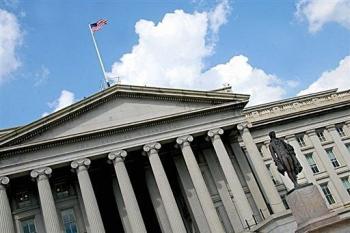Related article: Interview: Peter Schiff still grim on future:
“It’s not just U.S. stocks and real estate that are going to lose value, but U.S. bonds. This is the last bubble yet to burst. I think we’re going to see a collapse of the bond market sometime during Obama’s first term, and interest rates are going to spiral out of control, and the dollar is going to just be destroyed.”
‘Fear’ will always manifest for you exactly what you are afraid of.
__________________________________________________________________________
Investor fear drives US Treasury yields to near zero
WASHINGTON (AFP) – The panic in global financial markets has sparked an unprecedented rush into safe US Treasury securities, driving yields on short-term government notes down to almost zero.
Due to stampeding demand for safe short-term investments, the US Treasury’s four-week and three-month bills on Friday yielded an effective rate of 0.01 percent — down sharply from 1.515 percent and 1.785 percent, respectively, in early September.
Other Treasuries are also showing record low yields. The 10-year bond yield fell as low as 2.505 percent and the 30-year bond yield slid to 3.005 percent at one point on Friday. The six-month bond yielded a mere 0.20 percent.
The low yields reflect a surge in demand for these instruments, seen as the safest in the world during times of turmoil.
“Investors seem to be content to sell stocks and park into the bonds for now,” said Greg Michalowski of the financial website FXDD.
Analysts say the fear factor has pushed up demand for Treasuries, since investors are virtually certain the US government will not default.
Other factors include worries about deflation and the overall trend in interest rates, with the Federal Reserve having cut its base lending rate to a historic low of 1.0 percent, and further reductions possible.
But Bob Eisenbeis, analyst at Cumberland Advisors, said the unprecedented low yields are a sign of “dysfunction” in markets.
Eisenbeis said US municipal bonds are paying upwards of 6.0 percent tax-free and corporate bonds even more, but that fears of default and a lack of knowledge about underlying bond quality have led investors to shun these alternatives.
One reason for the surge in demand for Treasuries, said Eisenbeis, is the Federal Reserve’s decision to flood financial markets with liquidity including through other central banks.
Many central banks and commercial banks are reluctant to use this cash for traditional lending, and are buying Treasuries to ride out the storm, Eisenbeis added.
A big question for the market is whether the Treasury market has become a bubble that will burst.
Although the low rates allow Washington to borrow money cheaply, Eisenbeis said such a scenario could be perilous for the economy and the dollar.
“When you have this huge flood of liquidity into the marketplace, that can’t last forever,” he said.
A bursting of this bubble could mean a rush out of Treasuries, forcing the government to pay higher rates on an unprecedented amount of debt.
“We would have huge increases in our costs and people wouldn’t want to hold Treasury obligations anymore because of the capital losses,” Eisenbeis said.
“You could have a huge switch in interest rates very quickly.”
Mike Larson, an analyst at Weiss Research, says the long-term bond market could be “the biggest bubble of all,” worse than the dot-com and real estate bubbles.
“Treasury bonds almost never move this far, this fast. And interest rates, which move in the opposite direction of bond prices, almost never fall this far, this fast,” Larson said.
Larson said the yield on the 10-year Treasury bond plunged from a mid-October high of 4.08 percent to nearly 2.5 percent this week, “yielding lows not seen since the mid-1950s.”
“There are lots of reasons to believe this Treasury rally is unsustainable, and that a day of reckoning is fast approaching,” he said.
Sal Guatieri, economist at BMO Capital Markets, acknowledged that “investors are throwing money at Uncle Sam with the same conviction that they bought houses and dot-com stocks in their heydays.”
But he argued that if inflation is quashed and investors retain confidence in the US government, the dangers have not yet hit a boiling point.
“While Treasuries may be overpriced, they probably are not yet in a bubble,” he said.
Dec. 08, 2008
Source: AFP

1 thought on “The Biggest Bubble of All”